Peak shipping season may not live up to name this year
by December 6, 2022 4:11 pm 916 views

The holiday shipping season might be less “peaky” than usual amid a weaker retail environment in the fourth quarter, compared to the same period in 2020 and 2021, according to multiple reports.
A recent FreightWaves report shows consumers have been struggling with inflation that’s been evident at grocery stores and gas pumps for several months. This has limited discretionary budgets as consumers shift spending from goods to services.
While the holiday shipping season might not live up to its “peak season” name, this won’t be surprising because the transportation industry has faced unpredictability since the onset of the COVID-19 pandemic. The report cited a recent example in the third quarter when “the back-to-school shopping season failed to inject freight demand into a flagging market.”
But this wasn’t a surprise, according to the report. In the third quarter, major retailers reported high inventories and began to cancel orders, leaving their suppliers with unexpected inventory. As a result, the suppliers needed a place to store the inventory in warehouses, adding to supply chain constraints.
Also, spot rates fell in the quarter as carriers competed for business. The rates fell by 6.78% from the previous quarter and were down 14.3% from the third quarter of 2021. According to the report, spot rates are expected to continue to fall in the fourth quarter by low-single-digit percentages.
According to DAT Freight & Analytics, dry van spot rates declined by 1.5% in November from October. Rates were down by 18.5% in November from the same month in 2021. However, the rates increased by 1.3% for the week ending Dec. 4 compared to the previous week.
“Smaller carriers are already operating with razor-thin if not negative margins,” according to the FreightWaves report. “We will probably see a more substantial drop in contract rates for the quarter, given the abundance of pricing power recently gained by shippers. Since a considerable portion of shippers still abide by yearly bid cycles, (the first quarter of 2023) is more likely to be the time when larger carriers feel the screws begin to tighten.”
The U.S. Bank National Shipments Index declined by 2.6% in the third quarter. Compared to 2021, third-quarter shipments fell by 4.9%. The report noted that the comparison was “against one of the most robust retail spending seasons in recent memory.”
Freight volumes are projected to continue to tighten in the fourth quarter. The report cited maritime imports are a primary source of over-the-road truckload volumes, and the imports declined by 5.25% in the third quarter from the second quarter. The peak season for maritime imports is typically in August and September.
As a result, the bulk of truckload volumes will likely come from shippers moving their cargo from coastal warehouses to inland destinations, the report shows.
In the third quarter, the U.S. Bank National Spend Index fell by 2.4% from the previous period but remains 10.6% higher than in the third quarter of 2021. Spending is expected to continue to fall in the fourth quarter, but comparisons are projected to remain positive through the second quarter of 2023.
In a recent industry note, analyst Jack Atkins and associate Grant Smith, both of Little Rock-based Stephens Inc., said after 25 months, the Port of Los Angeles and Port of Long Beach announced the end of the containership backlog as imports and cargo are diverted to the East Coast. Congestion at the Port of Savannah was elevated, with 26 vessels awaiting a berth in the first week of December, up one from the previous week.
Meanwhile, transpacific container rates have fallen to levels not seen since the first quarter of 2020 as a result of weaker demand from U.S. consumers and excess capacity in the transpacific lane. According to the Freightos Baltic Daily Index, the rates per container from North China to the U.S. West Coast have fallen to $1,424, down 1.7% from the previous week. Before the pandemic, the rates were between $1,500 and $3,000 per 40-foot-long container. From August 2021 and April 2022, they were between $12,000 and $20,000.
“As a strange year for the transportation sector enters its final chapter, the focus for investors should shift from the complete lack of a peak season and the extremely weak current underlying fundamentals to 2023,” the analysts said.
They questioned whether the usual build of freight flows would come about in the second quarter, which would correspond to “more normal shipper inventory ordering patterns.” If this does come about, they’d expect outperformance in freight stocks, especially asset-based truckload and less-than-truckload. If not, it could lead to a longer-term downturn in freight volumes, which might result in doubts about a potential earnings recovery in 2024. Still, truckload stocks would likely outperform.
Asset-based carriers with brokerage segments, such as Lowell-based carrier J.B. Hunt Transport Services Inc., have been outperforming the broader market because they are investing in these arms as they look to boost revenue without adding assets and reducing cyclicality. Also, the carriers have been investing in their truck-only and drop-trailer offering, “which we believe is paying significant dividends given the limited trailer capacity in the market and changing customer preference.”
